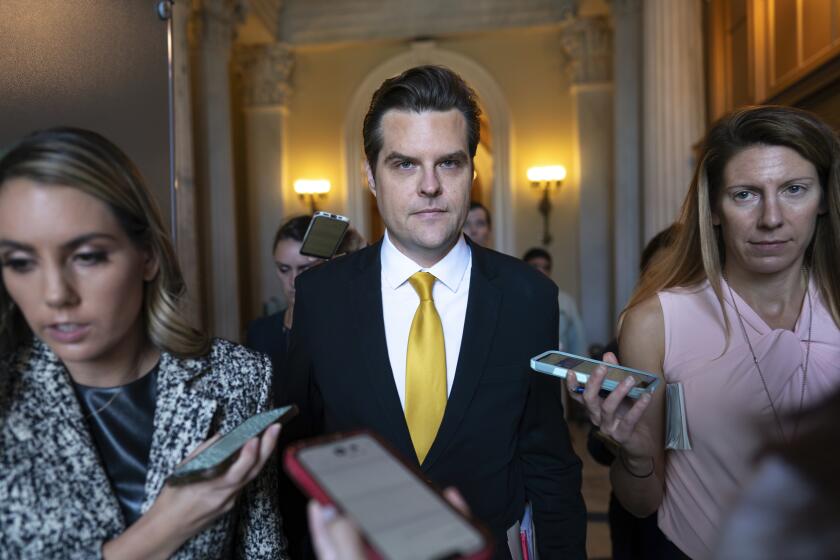L.A.âs Purple Line subway plan is bad news for the arts
Itâs hardly where youâd expect to find such news, but an environmental impact statement just issued by the L.A. County Metropolitan Transportation Authority for the Purple Line subway contains an ominous report on the status of the arts in Los Angeles. According to the document, before the transportation agency begins digging tunnels through the tar-and-fossil-filled veins of San Pedro sand that lie beneath Wilshire Boulevard, it will aim an above-ground wreckerâs ball at three of L.A.âs most vulnerable arts establishments, leveling the cityâs only architecture museum along with two other gallery spaces that are part of the cityâs Museum Row.
In the name of a greater good â extending the subway down Wilshire Boulevard to Westwood and, someday, the ocean â the buildings that house the A+D architecture museum and the Edward Cella Art+Architecture and Steve Turner Contemporary galleries will all be razed. The ill-fated stretch is directly across the street from LACMAâs Broad Contemporary and next door to the Petersen Automotive Museum.
Neither the architecture museum nor the galleries oppose the Purple Line in concept. As gallery owner Edward Cella says, âI have great sympathy for the subway project. Itâs a dream of all Los Angeles.â But that doesnât mean heâs happy about the ouster. âI purposely moved my gallery from Santa Barbara to be in this network of spaces next to the A+D, across the street from LACMA, down the block from the Petersen. The context is irreplaceable.â
Itâs not feasible, he says, to move elsewhere for the eight years of construction and then move back to the area. And even if he were willing to do so, Cella notes, the buildings that go up after the subwayâs completion are likely to be âcommercial or mixed-use or big hotels, nothing like the reasonable spaces and rents we have now.â
Under California law, Metro does not have to assess the impacts on cultural institutions less than 50 years old. This provision has allowed political leaders, from the mayor to the Board of Supervisors to the MTA board, to dodge what ought to be a spirited debate about the sacrifice that small, young arts spaces are being forced to make.
The subway builders insist there is no option. They say you cannot tunnel beneath the boulevard nor build the station box without an acre-plus of âstaging ground,â and thus the galleries and museum must be flattened. The land will be used to receive gassy soils and possible fossil finds and to park subway construction vehicles, equipment and office trailers.
But why is the space where these tiny arts institutions sit the only option?
There are a number of nearby sites without any buildings on them that could be used to stage the tunneling operation. Some belong to LACMA, whose real estate holdings in the immediate vicinity are large â and, it should be noted, tax-exempt. One of these is LACMAâs parking lot on Spaulding and Wilshire, two blocks east of the proposed staging area. There is ample acreage to store the construction equipment, keep LACMAâs lot open and spare the doomed buildings.
Much the same is true for LACMAâs vacant land behind the May Co. building. The museum agreed to hold this land open space in perpetuity, but for the past eight years it has been used for construction staging. Extending that use a bit further wouldnât be a disaster. The Petersenâs large parking structure might also be a suitable alternative.
This does not exhaust the list of potential sites, but the point is clear: The MTA has targeted the weakest kids on the block.
In doing so, the MTA will be acquiring a piece of land thatâs likely to bring it big dividends down the line. When the Wilshire trains start running, the agency will lease its land to a developer, and then share in the revenues of whatever is built. Metro currently makes about $14 million a year from its other âtransit-oriented developments.â The condemnation of a vital if vulnerable piece of the cityâs arts hub will only add to the dividend.
Would any other city abide wiping off the map a pair of galleries and a fledgling museum just to make a temporary construction site? Would this be happening in New York, London, Paris or Amsterdam?
Unless the MTA board acts to undo this piece of its $6.8-billion undertaking, a small pocket of cultural idealism will disappear from the cityâs landscape. If the MTAâs past is any indication, in its place will grow a work of lasting architectural defeatism and a monumental rebuke to the very notion that commerce and art must coexist. Saddest of all, we may soon forget this string of storefronts ever existed. Then someone will ask, unknowingly, while cruising Wilshire Boulevard, where is Museum Row? What civic leader will be responsible for that answer?
Greg Goldin is an architecture writer for Los Angeles magazine and co-curator of the upcoming âNever Built: Los Angelesâ show at the A+D museum.
More to Read
A cure for the common opinion
Get thought-provoking perspectives with our weekly newsletter.
You may occasionally receive promotional content from the Los Angeles Times.










